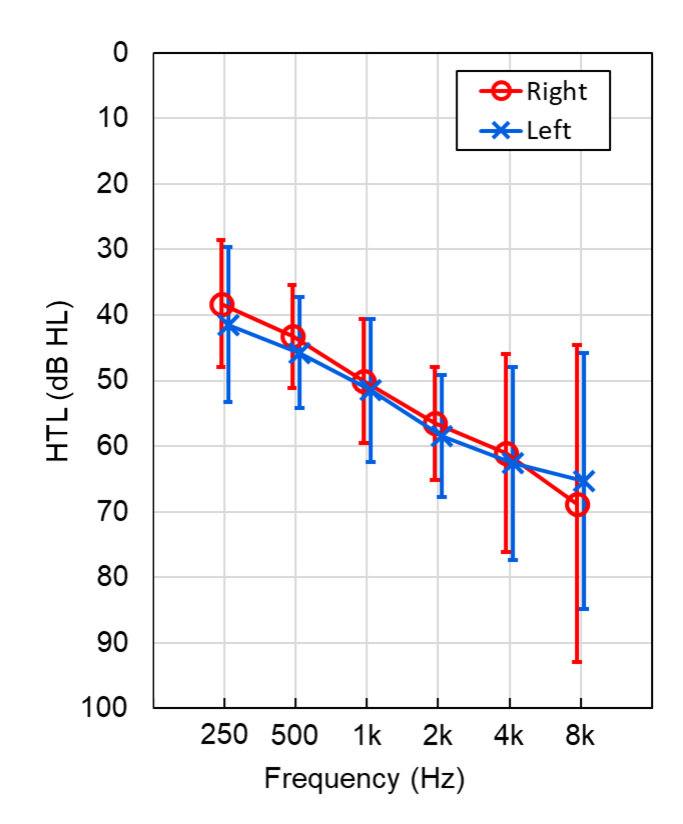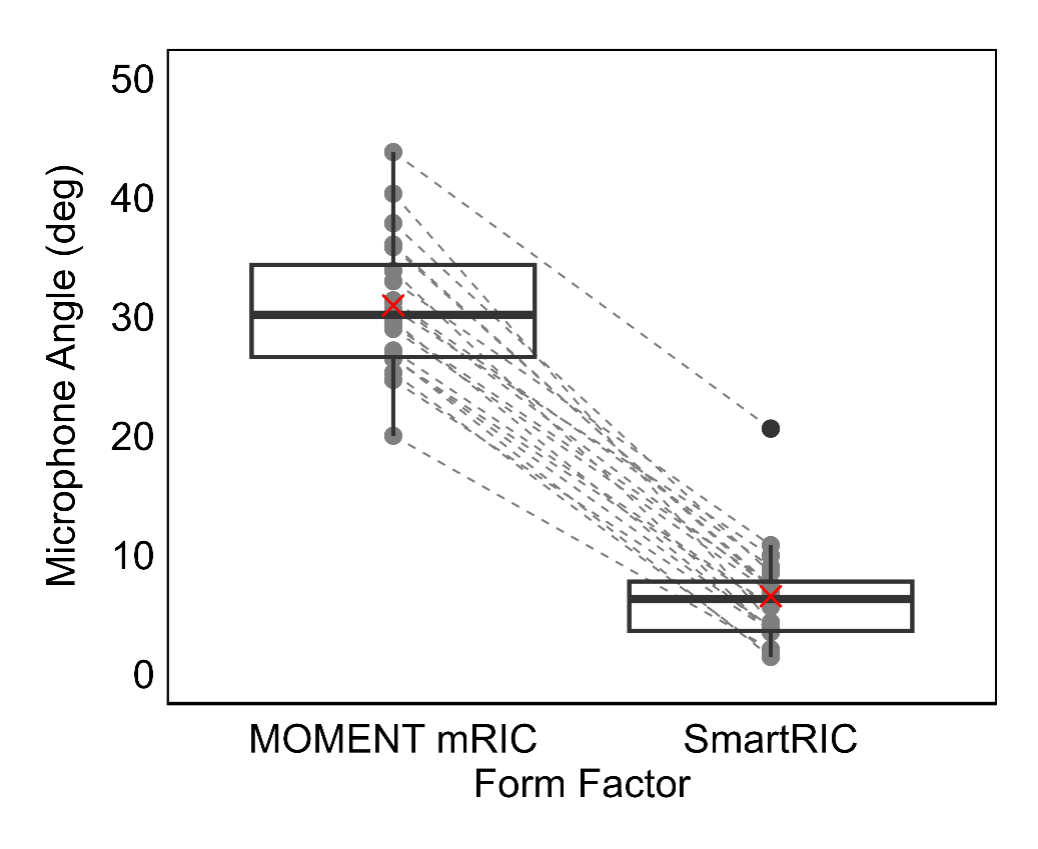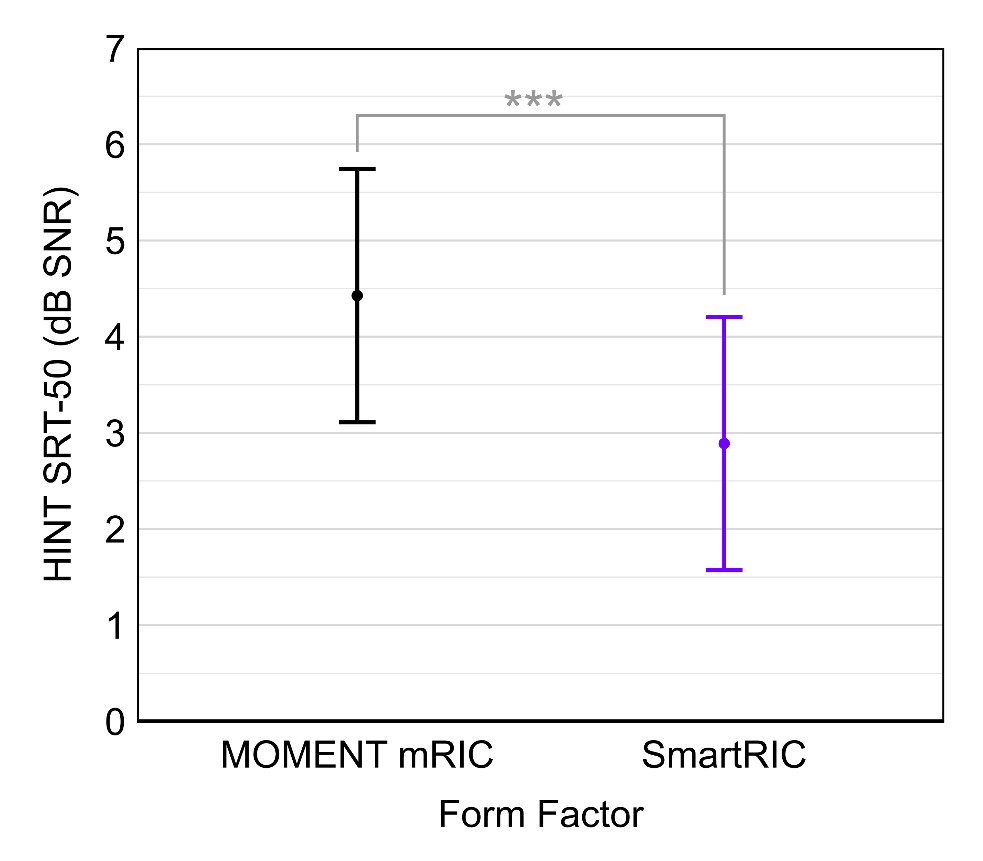Learning Outcomes
After this course learners will be able to:
- Discuss the effects of directional microphone angles relative to the horizontal plane.
- Describe differences between traditional RIC hearing aids and a new design the optimizes directional microphone port orientation.
- Implement clinical approaches to on-the-ear microphone placement.
Introduction
Hearing aid development faces many challenges. One of those challenges is that of housing design, which entails unique considerations in terms of cosmetics, space, and function. In addressing these characteristics, optimal design elements must consider stigma in a time when ear-worn devices are evolving into reflections of style and technological engagement. However, the design cannot compromise the intended use of hearing aids, but rather should enhance performance with hearing aids. In this paper, we evaluate a hearing aid design form that is intended to be aesthetically pleasing while optimizing directional microphone performance and through that speech understanding in noise.
Speech understanding in background noise is a constant issue for people with hearing loss1. Directional microphone technology has consistently been shown to benefit hearing aid wearers in noise2-4. In general, directional microphones can improve the signal-to-noise ratio (SNR) by reducing amplification for sounds that approach from the rear field. One factor that can impact directional microphone performance is the horizontal microphone angle. A smaller angle results in a more horizontal microphone port alignment and consequently better directionality. Directional processing depends on sound hitting the two microphone ports at different times. While in the horizontal plane, the ports are at their maximum distance which is where they can achieve optimal performance. When that angle shifts, the distance between the ports is essentially reduced, thus reducing the potential directional effect.
One method of measuring directional performance is the Directivity Index (DI). The DI provides a numeric value for indicating how effective a directional microphone is over an omnidirectional microphone. Using DI calculations, one can show a decrease in directional performance with increased deviations from the horizontal alignment. The less horizontally aligned the microphone ports are, the lower (poorer) the DI. In previous investigations on directional microphone alignment and DI changes, Ricketts5 reported that a variance of over 10 degrees from the horizontal plane could have a significant effect on directional performance.
When one considers current Receiver-in-Canal (RIC) designs, there is an apparent attempt to optimize cosmetics. The body of the device rests mainly behind the pinna, while the wire of the receiver arches over the pinna to place the receiver itself in the ear canal. With this design, the most visible portion of the hearing instrument is the receiver wire. Such designs result in challenging the horizontal placement of the microphones as the placement of the device has an angle that limits horizontal microphone alignment.
A recent RIC design by Widex, the SmartRIC, has focused on achieving a more horizontal microphone port alignment while optimizing cosmetics. The utilization of an inverted “L” shaped housing permits a higher placement of the rear microphone compared to the traditional lower placement with its resulting downward angle between the microphone ports. Additionally, this housing design offers a more modern look to help address stigma surrounding hearing aids. Figure 1 shows a comparison of a more traditional RIC design beside the SmartRIC design.

Figure 1. A side-by-side visual comparison of the Moment mRIC (left) and the SmartRIC (right) hearing aids.
A recent study by Kuk et al6 comparing the SmartRIC design to a traditional RIC design confirmed a more horizontal alignment of the microphone ports on the SmartRIC as well as improved Hearing in Noise Test (HINT)7 scores with the SmartRIC. Since the two sets of hearing aids offered the same processing (gain, noise reduction, etc.), these results suggest that the housing design supporting the microphone alignment does result in improved speech intelligibility in noise compared to a traditional housing and steeper microphone alignment.
In this study, we sought to replicate the Kuk et al study in another lab and investigate the capabilities of the SmartRIC to provide more horizontal microphone port alignment compared to that of a traditional RIC device and if this results in improved speech intelligibility in noise.
Methods
The study was completed at the Speech-Language Pathology and Audiology Clinic at the University of Northern Colorado. Participants consisted of twenty experienced hearing aid wearers with mild to moderate hearing loss (see Figure 2 for audiogram).

Figure 2. Mean audiometric results. Error bars indicate one standard deviation on either side of the mean.
Hearing Aids
All participants were fitted bilaterally with both the Widex SmartRIC and Widex Moment mRIC hearing aids using M-receivers. Wire lengths were selected as appropriate for participants’ ears. Coupling was completed using closed tips. Hearing aids were fitted to the Widex Compass programming software implementation of the NAL-NL2 fitting formula. Devices were set to a fixed directional mode with noise reduction activated. Real Ear to Coupler Difference (RECD) measurements were matched within 2 dB via the Audioscan Verifit 2 hearing aid test box to assure the same output from both devices.
Procedure
Participants were seated in a chair in a sound-treated test booth. Participants were asked to sit with their head in a comfortable position while resting on a chin rest. The chin rest was used to ensure a stable and consistent head position during testing such that head position would not alter the fitted hearing aid microphone positions.
Hearing aid microphone angles for all devices were measured on the ear with the head in the chin rest. Measurements were first conducted with the Simple inclinometer app (version 1.81 from Syleos Apps). Subsequently, in-situ photographs were taken of the devices, and the microphone angle images were calculated using the Inkscape graphics editor program (version 1.3.2). A correlation (r=.97) between the measured angles obtained via the inclinometer and the photographs suggests a good estimation of the angles with both tools. Results will be presented from the angles measured in the graphics software.
For the speech in noise test measure, participants completed a modified HINT. The target HINT sentences were presented from a 0° azimuth speaker in an adaptive manner beginning at 75 dB SPL. Background noise consisted of a two-talker speech babble presented at a cumulative fixed level of 70 dB SPL from loudspeakers positioned at 90°, 180° and 270° azimuths. Both sets of hearing aids were tested in the directional mode. Testing was counterbalanced and each hearing aid condition was tested with two trials, using a different HINT sentence list for each trial presentation.
Results
The angles measured between both microphone ports on the Moment mRIC devices and the SmartRIC devices are shown in Figure 3. The angles for the Moment mRIC ranged from 20° to 43.8° with a mean of 30.9° and for the SmartRIC, the range was 1.4° to 20.6° with a mean of 6.5°. These results are expected, confirming that the microphone angles on the SmartRIC are significantly smaller (more horizontal) than those on the Moment mRIC.

Figure 3. Microphone angles measured between the Moment mRIC and the SmartRIC. The boxes indicate upper and lower quartiles, while the line represents the median. Circles represent individual results and X’s represent group means.
Results from the HINT (Figure 4) are displayed showing the SNR level at which 50% sentence accuracy (SRT50) was achieved. The mean SRT50 with the SmartRIC across two trials was 2.89 dB and the mean SRT50 with the Moment mRIC across two trials was 4.43 dB.

Figure 4. Averaged SRT50 between the MOMENT mRIC and SmartRIC (n=20). Error bars represent 95% confidence interval of model fit.
A linear mixed effects (LME) model analysis was conducted investigating the effects on HINT performance of form factor (Moment mRIC vs. the SmartRIC) and Trial (1 vs. 2). Results showed a significant effect of Form Factor (χ2 = 42.59, p<.001), but no significant effect for Trial. These results are consistent with the expectation that the SmartRIC would provide lower (better) SRT50 results.
Discussion
In this investigation, we evaluated the difference in on-the-ear horizontal microphone port alignment between the Widex SmartRIC and the Moment mRIC as well as the differences between HINT SRT50 results using the two devices.
The microphone angles were clearly more horizontal with the SmartRIC with a 24.4° difference between the mean values of the devices. This improvement in microphone alignment suggests higher directivity index (DI) values are possible with the SmartRIC compared to traditional RIC microphone placement, as also confirmed by the DI measurements reported by Balling et al8. Behavioral testing was consistent with that expectation, as the mean HINT SRT50 results between the two devices showed a difference of 1.5 dB SNR with the SmartRIC SRT50 resulting in a lower SNR (better result).
Another goal of this study was to compare our results to those of Kuk et al6. In their evaluation they observed a 25° difference between angles of the two pairs of test devices. This is very consistent with the 24.4° difference we observed. This further supports that the SmartRIC provides a much more horizontal alignment of the microphone ports compared to the more traditional RIC design. Furthermore, the HINT results from the previous study indicated a 1.25 dB improvement in SNR with the SmartRIC. In the current study, we observed a 1.54 dB improvement in SNR for the SRT50. Again, these results are consistent with those of the previous study showing improved speech in noise performance with the SmartRIC over the more traditional RIC design.
These results also align with those of Ricketts5 and the implication that microphone angles over 10° could have a significant impact on the DI. In the current study, we do indeed see a significant effect of the microphone port alignment difference in behavioral testing. Ricketts measured DI values at different angles with devices placed on a Knowles Electronic Manikin for Audiologic Research (KEMAR). In these measures, poorer DI values were calculated for steeper microphone alignment. However, it was also reported that a helix effect would have an additional impact on the DI of a more steeply sloping microphone port angle by covering the microphone ports. This effect may have factored into the performance we observed in this study. However, that further supports that attention to the microphone alignment has critical effects on directional performance for the hearing aid wearer.
One broader consideration for clinicians is the awareness that wire length selection for RIC devices could influence the microphone angles on the hearing aids. While selecting a device and wire length to comfortably and cosmetically fit the physical anatomy of a wearer, the clinician should also be aware of the impact on the microphone alignment to ensure optimal directional performance. Additionally, the use of a chin rest in this study addressed the impact of head movement might have on changing the positioning of the microphones. For patient use while the devices are worn, head movements can still offset optimal alignment in relation to a speech source. However, clinical attention to the wearing position of the microphones can reduce the degree of deviation from the target speech source.
In this study we replicated the approach used by Kuk et al in measuring microphone port alignment angles between the recently introduced Widex SmartRIC compared with Moment mRIC hearing aids. Results were consistent with the previous research and further support improved directionality for speech in noise situations with optimal microphone placement.
References
1. Picou, E. M. (2022). Hearing aid benefit and satisfaction results from the MarkeTrak 2022 survey: Importance of features and hearing care professionals. Seminars in Hearing, 43(4), 301-316.
2. Wu, Y. H., Bentler, R. A., Jiang, H., & Jensen, D. R. (2019). Efficacy and effectiveness of advanced hearing aid directional and noise reduction technologies for older adults with mild to moderate hearing loss. Ear and Hearing, 40(4), 805-822.
3. Kuk, F., Keenan, D., Korhonen, P., & Lau, C. (2020). Efficacy of directional microphones in open fittings under realistic signal-to-noise ratios using Widex Moment hearing aids. Hearing Review, 27(6), 20-23.
4. Kuk, F., Slugocki, C., & Korhonen, P. (2020). An integrative evaluation of the efficacy of a directional microphone and noise-reduction algorithm under realistic signal-to-noise ratios. Journal of the American Academy of Audiology, 31(4), 262-270.
5. Ricketts, T. (2000). Directivity quantification in hearing aids: Fitting and measurement effects. Ear and Hearing, 21(1), 45-58.
6. Kuk, F., Korhonen, P., Slugocki, C., & Lau, C. (2024). Forms influence functions: Microphone angle and speech-in-noise performance. Hearing Review, 31(3), 14-19.
7 Nilsson, M., Soli, S. D., & Sullivan, J. A. (1994). Development of the Hearing in Noise Test for the measurement of speech reception thresholds in quiet and in noise. Journal of the Acoustical Society of America, 95(2), 1085-1099.
8. Balling, L. W., Nygaard, E. M., Jensen, K. K., & Andersen, H. (2024). Introducing the Widex SmartrIC™: When design meets performance. WIDEXPRESS, (54).
Citation
Weber, J. & Branda, E. (2024). Smart directional design. AudiologyOnline, Article 29014. Retrieved from https://www.audiologyonline.com



